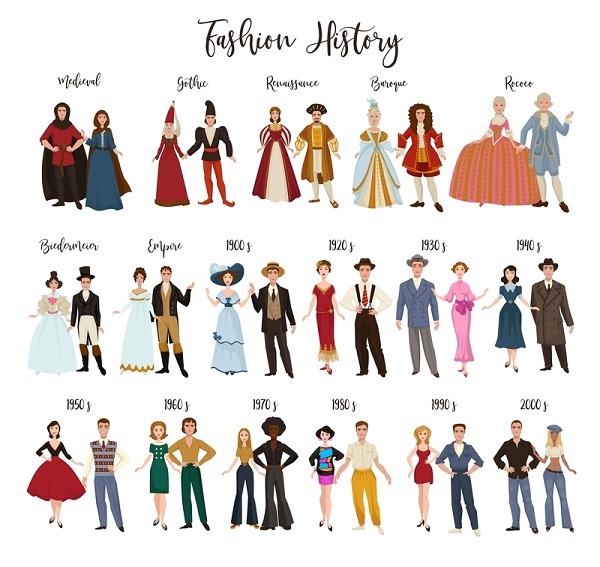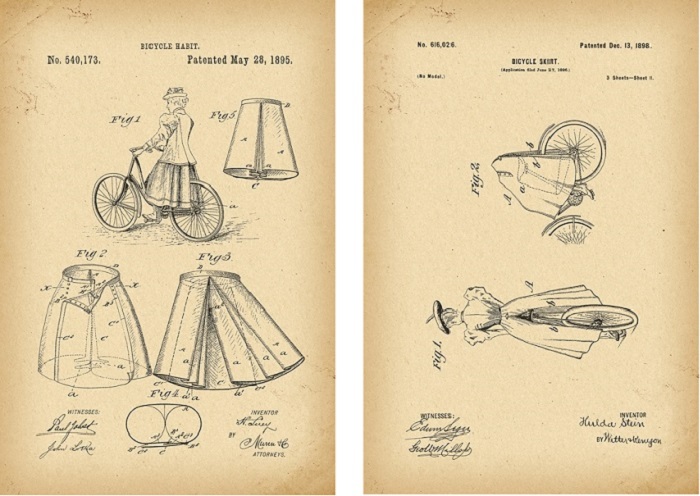

Fashion in the 18th century was not only inspired by the styles of the 17th century but also created styles that still inspire today's fashion. Historians find it difficult to define or categorise the fashion of this century. In “Dress in Eighteenth-Century Europe, 1715-1789” fashion historian Aileen Ribeiro laments that when people think of fashion in the 18th century, they mostly refer to fashion in Paris or France. They do not mention the fashion evolving in different parts of the world or even in England or Italy. This portrays how popular the fashion of 18th-century France was. She also says that this French taste still influences our new-age fashion. With this background in mind, the article will discuss the history of fashion in the 18th century and more specifically women’s fashion.

Evolution of fashion trends
Description-Evolution of fashion trends from the mediaeval period to the 20th century
18th-century fashion had many signature styles. Women wore corsets and mantuas. The mantua had a slit through which the matching underskirt or petticoat was made visible. These long dresses usually had several petticoats which gave a voluminous look to the dress. These dresses were decorated mostly with jewellery, ornaments, and embroidery. The most luxurious of them were made of silk. In the case of men, they wore a knee-length coat that looked like a skirt at the bottom, paired with a long waistcoat, knee breeches, stockings and leather shoes. It is interesting to note that both men and women wore hats during this century. Men had also worn shoulder-length wigs. In the case of women, their hair was loosely tied typically with laces and covered with caps. A hat then covered this cap.

1895 Patent Velocipede victorian fashion style Bicycle history gothic apparel dress clothes costume skirt invention
To dress like a woman of 1800 a full-length dress is a must. Several petticoats have to be worn below the dress to give the dress volume. The dress is usually bell-shaped and paired with a corset above the waist. For the hands, long gloves which go beyond the elbow are also mandatory. For feet thigh, high stockings should be worn paired with boots. The hair must be loosely tied and covered with a cap or hat.
Fashion is one of the important indicators of people’s financial status. Rich people usually buy clothes from luxurious brands, and people with low incomes or poor people usually use clothes at low market prices. Thus, the price of clothes is mostly equivalent to their quality. This applies to countries as well. More rich and developed countries will have more luxurious fashion due to the affordability of resources to produce the fashion or the availability of resources in their country.
Various social factors influence fashion. A person’s gender is a significant criterion for choosing fashion. Males and females generally have different clothing requirements which decide their taste in fashion. The marital status of a person is also an indicator of their fashion choice. In many cultures and traditions, married women are required to wear evidence of their marriage in the form of clothing or jewellery or makeup. Similarly, people’s class, ethnicity, educational background, and religious association also decide their choice of fashion.
This is one of the important factors in the world of fashion. Professions which require people to wear specific clothes create their place in the space of fashion. For example, nurses, policemen, pilots, etc all have different sets of uniforms. Especially in the case of females, working women will have a different sense of fashion than housewives. Their fashion may be inspired by the outside world with which they interact daily unlike the housewives.
The climate of a particular region also decides their fashion trend. People who experience cold or warm weather for most of the year will choose their clothes accordingly to survive that particular weather.
This factor includes inspiration for the latest fashion trends from models or movies or celebrities or fashion icons.
Political situation of a country or specific region also influences its fashion. Some political governments may ban certain clothes for their citizens. In most cases, the government may control the import of certain materials for the production of fashion materials and this will directly affect the fashion trends in the region.
Fashion is an evolving platform. In today’s world which is interconnected due to globalisation and the latest communication technologies, fashion from different parts of the world is creating innovative fusions. Nowadays, fashion designers create well-researched pieces of fashion. Their inspiration is no more limited to 18th-century ideas, rather their inspiration comes from far corners of the world some of which are mostly unrecognised in the luxurious fashion world.
Q1. How do media platforms influence fashion?
Ans. Media platforms like televisions, social media, multimedia, and magazines promote different fashion brands. They keep people up to date on the latest fashion trends, and they also publish the latest styles pursued by a popular model or celebrity. This way they create or erase fashion trends from people’s minds and the fashion market.
Q2. What do you understand about the physiological factors that influence fashion?
Ans. Physiological factors like skin colour, height, body shape, and age of a person also influence their choice of fashion. People of different ages wear different kinds of clothes depending on their comfort. Similarly, people with darker skin colour may not choose to wear certain colours depending on their preferences or taste.
Q3. Which psychological factor influences fashion?
Ans. Psychological factors also influence people’s taste in fashion. Some people may not follow the latest fashion trends since they are comfortable with their sense of style. In some cases, people might wear a certain colour on a specific occasion if they believe the colour to be auspicious. Similarly, people’s mood also influences their fashion choices.